Silicone lubricant is a great multi-use tool that just about everyone should keep in their home. A lot of people think that they can use regular WD-40 for most of their lubrication needs, but this isn’t usually the case. Standard formula WD-40 and similar products are primarily mineral oil-based. This means that they have some mild lubricating properties, but the solution is more of a solvent than a lubricant. It’s certainly nothing when compared to the lubricating properties of a silicone-based spray. Not only does silicone provide significantly more lubrication, but it’s also both heat and water-resistant. This makes it an ideal choice for use on machines that spend a lot of time outdoors, like your car.
Advertisement
I’ve been using silicone-based lubricant on my cars for years now, and I’ve seen firsthand that there are quite a few different applications for this handy little spray that can help you to keep your vehicle in good working order. Some of them take advantage of its lubricating properties, while others can help with things like rust prevention. Most applications benefit from both. Here is a quick peek at a few handy ways to use silicone spray on your car.
Lubricate hinges
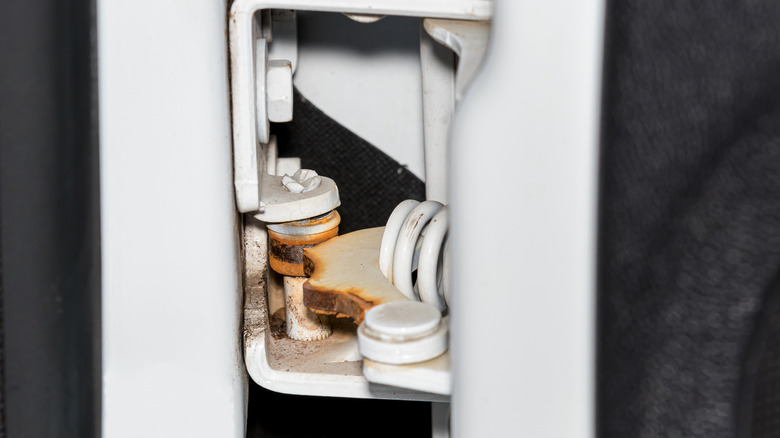
J.J. Gouin/Shutterstock
Car and truck hinges see a lot of exposure to the weather. Sure, manufacturers do their best to keep them protected by concealing them inside the door panel, but a little water is going to get in every time you open the door in the rain. This eventually leads to your doors making the same groaning noises you make when you try to get out of bed after your first day back at the gym. Over time, these hinges can even start to stick, making them difficult to open and shut.
Advertisement
You might need to clean them out with a solvent first if there is already a buildup of rust, but a quick spurt of penetrating silicone spray on a clean hinge helps to lubricate the metal. This way, your doors swing open and close smoothly and quietly. On top of that, the silicone’s water resistance also protects the hinge from moisture, preventing any further erosion from occurring. Simply spray the outside of the hinge and allow the lubricant to penetrate into the gaps between the metal. I live in Oregon, where it rains about 50% of the time, and I’ve found that a light coat once a year around the start of fall keeps my doors swinging easy.
This isn’t just for door hinges, either. You can also use the spray on your trunk hinges, gas cap cover hinges, glove box hinges, and center console hinges. It’s particularly useful for truck bed hinges, since they tend to see the most exposure to water.
Advertisement
Soften your weather stripping
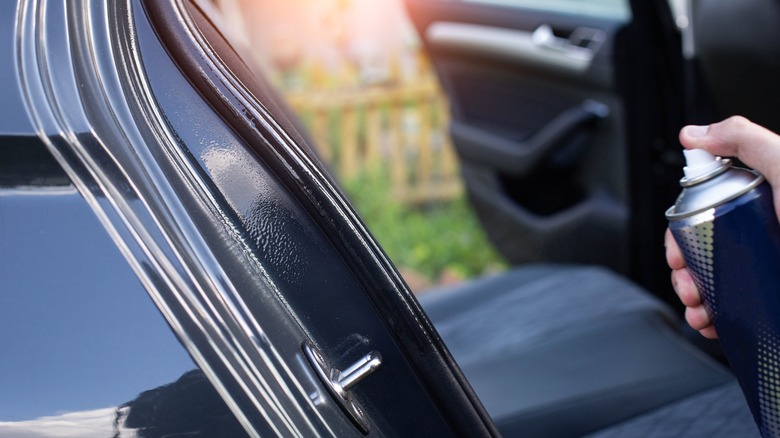
HenadziPechan/Shutterstock
Hinges may be the obvious first place to use a lubricant, but there are a lot of other ways to use silicone spray that you might not think of. For instance, did you know that you can use it as a conditioner for the weather stripping in your car? Unlike regular WD-40, silicone spray is safe to use on rubber.
Advertisement
Keeping your weather stripping in good condition is important for mitigating leaks in your vehicle’s cabin. These simple rubber tubes keep water out of your cab when it rains and help to keep heat and AC inside while you’re driving. But fluctuating temperatures can eventually make this weatherstripping become dry and brittle. Factor in the constant banging of metal doors, and you might start to see this material crack and tear, rendering it ineffective.
All you have to do to prevent this from happening is take a can of silicon spray and a rag, spray the rag, and then use it to massage the silicone into the weather stripping. This will condition the rubber, keeping it soft and adding a layer of protection that will help keep it supple and effective for much longer. This also works on the weather stripping outside your windows, which can help keep water from getting inside your door. I don’t have a set schedule for this kind of maintenance. I just do it whenever I notice that the weather stripping in my car is starting to feel a little stiff.
Advertisement
Lubricate hydraulic pistons
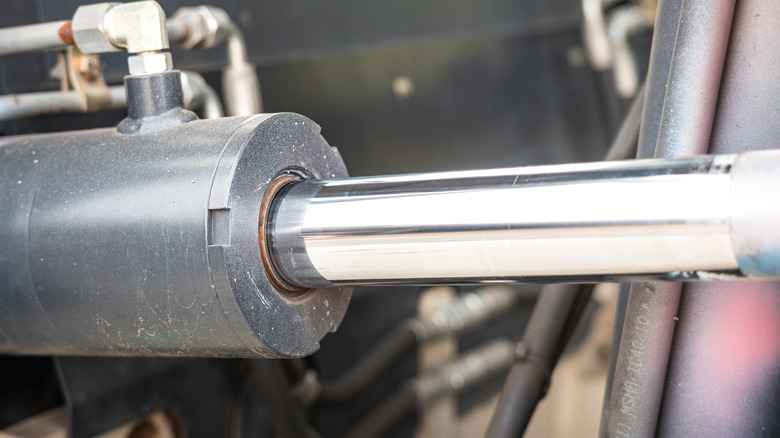
Nattawit Khomsanit/Shutterstock
While they were once something of a novelty, many new hatchbacks and SUVs have hydraulic power doors at the rear of the vehicle that automatically open with the touch of a button. These can be very convenient when you’re juggling grocery bags and don’t have a free hand, but they can also have problems of their own.
Advertisement
Sometimes, dust and debris manage to build up in the gaps. This can lead to whining and other issues. I personally had a problem earlier this year with this. My Rav4 was stuttering open in a jerky motion and making a creaking sound as it lifted.
To fix this, I simply sprayed the pistons with silicone and then used a rag to rub the substance into the metal and the surrounding hinges, making sure to get it in all of the gaps. Once that was done, I opened and closed the door a few times to let the lubricant work its way into the piston chamber and boom. No more stuttering. No more creaking. The door started opening smooth as silk and I haven’t had an issue with it since. This should also work for hydraulic bars in your hood, trunk, or anywhere else that you might have them in your car.
Advertisement
Lubricate locks and levers
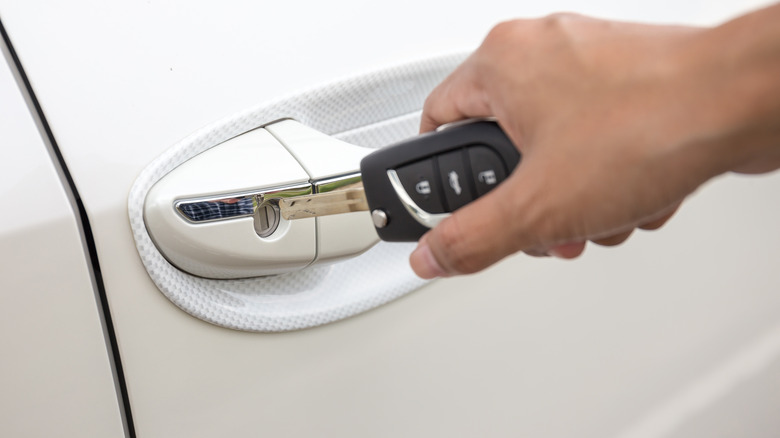
Powerbeephoto/Getty Images
The door locks and levers on the outside of your car probably see more exposure to weather than any other mechanical components. Manufacturers do their best to keep moisture out, but there is only so much they can do from an engineering perspective. Water and vapor that creeps into these components can eventually cause them to stick, making it difficult to turn a key in your lock or open the door once you do. The widespread use of key fobs has made locks less of a concern on newer cars, but it’s still good form to keep every part of your car in good working order.
Advertisement
A quick spurt of silicone-based lubricant can’t help with this. You’ll want to pull the lever fully open and then use the spray can’s straw to target the mechanism underneath. Most car locks have a sliding plate just inside the keyhole that’s designed to keep water from getting inside. This can make applying lubricant tricky. I’ve found that the best method is to place the tip of the key into the lock to move the plate and create a small gap at the top. I then use the straw to target the gap and give the lock a very light spray. Then I use the key to work the lubricant into the lock, allowing it to move through the internal pins and cylinders.
Lubricate the door latch
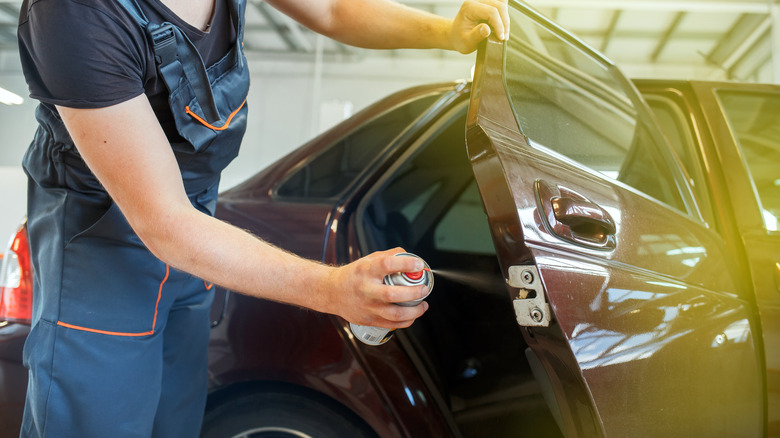
Sergei_Salnikov/Shutterstock
Have you ever had a car where you needed to slam a door shut in order for it to properly latch closed, even though the hinges swung fairly easily? The problem could be that the door is misaligned, which would require a bit of bodywork to fix, but it also might just be that the latch isn’t moving freely.
Advertisement
Car doors open and close a little differently from the kind you find in houses. There is a clip inside the door that latches onto a metal ring which is welded to the vehicle’s frame. When you pull the lever, the latch is released and an internal spring pushes it back up so that the door pops out. Dirt and erosion can cause this mechanism to stick, making the door difficult to open and close.
Depending on the severity, this may need to be disassembled and cleaned, but a bit of silicone lubricant can help the mechanism move more freely. Applying the lube to the mechanism semi-regularly (once a year or so) should also help to prevent this problem from ever developing. The water-resistant properties of the silicone will help to keep the latch clean and rust-free.
Advertisement
Lubricate seatbelts
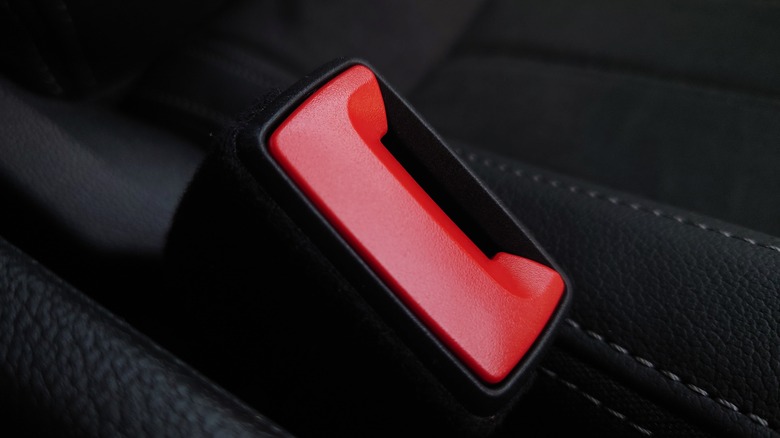
Pawellpi_photo/Shutterstock
Another good use for silicone spray is to lubricate your seatbelts. If you’ve ever had an issue with a seatbelt getting stuck and not wanting to unlatch, then you know firsthand how frustrating it can be. In the worst-case scenario, you might even find yourself stuck, and unable to get to the tools that you need in order to free yourself. My mother used to have a minivan that had one seat we all avoided precisely because the seatbelt was so finicky. She dealt with the problem for years before learning that a small dose of lubricant could fix it.
Advertisement
Silicone spray can help keep your safety belt in good working order by lubricating the internal mechanisms and keeping all of them working smoothly. It won’t remove the crushed-up remains of Goldfish crackers that a toddler managed to stuff in there, but it will help keep the moving parts inside the seatbelts safe from normal dust and debris. Simply use the straw attachment to target the slot where the tongues enter the buckle. One or two quick sprays should be plenty. You may also wish to wrap a rag around the base of the buckle to prevent any of the lubricant from accidentally getting on your upholstery. Give the lube a few minutes to penetrate, and then simply clasp and release the belt a few times to make sure that it’s working properly.
Advertisement